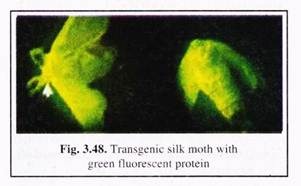The following points highlight the four major advances in sericulture. The advances are: 1. Transgenic/Genetically Modified Silk Moth 2. Transgenic/Genetically Modified Mulberry Plant 3. Silk as Bioreactor 4. Other Progresses.
Sericulture: Improvement # 1.
Transgenic/Genetically Modified Silk Moth:
With the help of different genetic techniques like cloning, RNA interference, etc., scientists have developed many transgenic silk moths with desired traits as follows:
(1) Transgenic silk moths (Fig. 3.48) expressing fluorescent proteins can produce large amounts of fluorescence-coloured recombinant silks. Tape-stries, other textiles and lamp shades were produced from the recombinant silks and evaluated for practical use.
ADVERTISEMENTS:
(2) By introducing a gene for an acidic peptide into silkworm, scientists developed thin silk. This silk thus produced by transgenic silkworm is thinner than that of the original race.
(3) Spider silk produced by transgenic silk moth has more strength and elasticity and is much more stronger than normal silk, so could possibly be used to make sutures, artificial limbs and parachutes.
(4) High yielding silkworm hybrids were developed using the DNA marker technology and then released to farmers of many places like Andhra Pradesh. Karnataka and Tamil Nadu (viz., Swar- nandhra, Hemavathy and Kalpava-tharavu).
ADVERTISEMENTS:
Again, many tropical bivoltine breeds, viz., CSR hybrid series (CSR6 x CSR26), (CSR2 x CSR27), (CSR48 x CSR5). (CSR2A x CSR4A). (CSR2 x CSR4), (CSR2 x CSR5), (CSR18 x CSR19), etc. were also developed and are being introduced in Indian sericulture successfully.
(5) Transgenic B. mori was produced by RNA interference (RNAi) for viral resistance against nucleopolyhydra virus BmNPV.
Sericulture: Improvement # 2.
Transgenic/Genetically Modified Mulberry Plant:
(1) Transgenic mulberry lines with HVA-1 gene for abiotic stress tolerance have been developed. Total area under mulberry cultivation for sericulture in India is about, 79. 065 ha of which 45 to 50% area are prone to abiotic stresses (drought, alkalinity and salinity).
ADVERTISEMENTS:
In order to develop suitable mulberry varieties, tolerant to drought and salinity, the DBT launched a programme at University of Delhi South Campus (UDSC), New Delhi.
(2) Evolution of high yielding mulberry varieties like V I (victory I) and S36 giving phenomenally higher leaf yields.
Sericulture: Improvement # 3.
Silk as Bioreactor:
The silkworm, Bombyx mori, has been used for silk production for centuries but recently also for protein production, as a bioreactor. Since Maeda et al. (1985) reported the production of human a-interferon in silkworm larvae, using recombinant B. mori nucleopolyhedrovirus (BmNPV), the production of many other proteins has been achieved.
(1) TOR AY Ind. Inc. (Tokyo, Japan) used silkworms to produce two recombinant proteins for veterinary use.
(i) Intercat, a drug principally composed of feline interferon, for feline calicivirus infections (commonly known as “cat flu”) was introduced in February 1994 as the world’s first antiviral drug for animal use.
(ii) Interdog, a drug principally composed of canine interferon-γ for canine atopic dermatitis, was launched in December 2005. Nowadays, recombinant proteins produced from silkworms are being investigated for commercial purposes.
(2) Luciferase and green fluorescent proteins were successfully expressed in silk moth utilising silkworm as a bioreactor (Indian Institute of Science, Bangalore).
Sericulture: Improvement # 4.
Other Progresses:
ADVERTISEMENTS:
(1) Characterisation of anti-bacterial proteins in silkworm has led to the discovery of unique insect specific lysozyme (similar to C-type lysozyme and alpha-lactalbumins).
(2) Process for degumming of silk with fungal protease enzyme has been standardised and found economically viable without chemical hazard.
(3) Development of integrated nutrient management measures comprising of various bio-agents for mulberry cultivation.
(4) Development of bio-control agents against root rot, root knot and nursery diseases of mulberry plant and bed disinfectants against various silkworm diseases.
(5) Development of integrated pest management measures against various pest of mulberry and silkworms.
